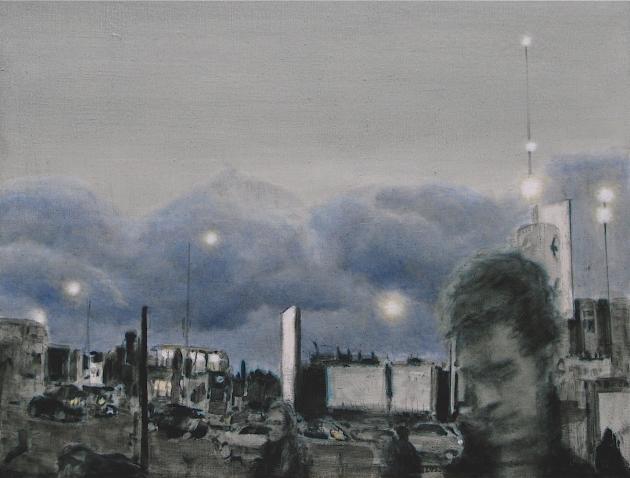This exhibition has a bold ideological mission to represent 21st century painting as a distinct, vibrant discourse. Painting – despite its much heralded and never quite delivered death – is a timeless artform. Now it has to contend with the preponderance of the digital image, not as a rival but as a topic of investigation, its mission is to cope with and reflect upon the digital age, where the image is forever in flux and subject to manipulation. In some sense, all the artists shown are grappling with this notion.
An exemplary work is Jules Clarke’s Freeman’s Pool (2013): an ordinary scene of bathers in what appears to be an outdoor urban swimming pool rendered strange with the blurred, grainy quality of the digital image, as if a painterly expression of the pixels in a newspaper photograph. Katherine Russell also extracts a certain strangeness from the familiarity of the image in her Guantanamo (2014), where the prisoners’ distinctive orange jumpsuits glow in the soft light of the desert, sounding an unheeded warning to the consumers of mass media. In Blue Cloud (2013), Marguerite Horner captures a very 21st Century urban pathos. Painting has here assimilated itself to the way we are used to consuming images by emulating the onslaught of digitalisation and in the process abstracting it in such a way as to be a tool of critique.
The meaning of painting is in the act of making, where the canvas should be read as an expression as much as a representation. Natalie Dowse’s Road (2012) paintings are grey, brooding images where the meaning is contained within her choice of subject, mastery of colour and the expressive potential of form. Paul Galyer’s Constellation (2013) has an awkward collision of elements – outer space, plant life, rock formations and Pop art sauce bottles – that defy a purely visual interpretation. Painting is not the act of making pictures of the world so much as it is an expression about humanity in the world.
The exhibition benefits from intelligent, light-touch curation; each room subtly follows a visual theme which emerges from the paintings but is never clumsily overstated. In a room which emphasises colour and form, Nathan Eastwood’s Nook (2011) brings to mind George Shaw’s use of Humbrol enamel to create moody swaths of colour that conceal a dark secret within an innocuous image. Harvey Taylor’s photorealist The Sea at Mersea II (2013) elegantly captures the glint of light on the surface of the sea, resulting from his careful handling of an array of colours. A room of loosely surrealist works includes Pen Dalton’s Holiday in Valencia (2014), a heady mixture of screen printing, paint and gold glitter, which gives the impression of wild abandon but is very deeply deliberate.
The 20th and 21st Centuries taught us that humanity has a limitless capacity for malice and catastrophe, and this exhibition proves that painting has an inexhaustible ability to capture every nuance of life in any epoch. In the gallery’s atrium is Stephen Newton’s beguiling Room at Night (2003), a large canvas loaded with thick layers of paint in the manner of Kiefer. That claustrophobic scene, pregnant with possibility and emotion, reminds us that painting is every bit as timeless as human error.
@PaintBritain Ipswich Art School Gallery
15 November 2014 – 8 March 2015
Words: Dr Daniel Barnes – Image: Marguerite Horner © 2015 all rights reserved

